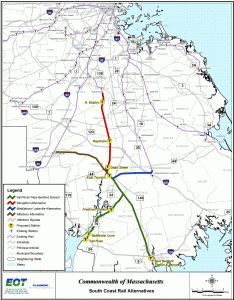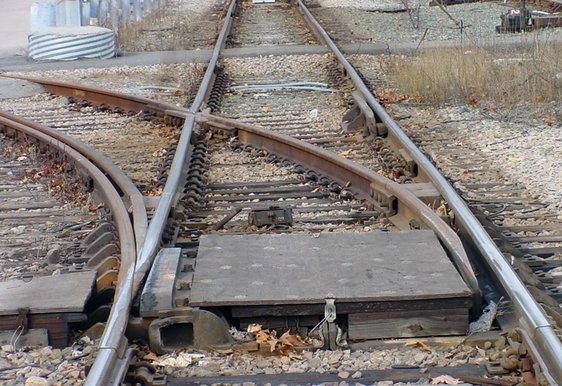
It is common knowledge that the prospect of a direct rail connection between Massachusetts’ South Coast (specifically New Bedford and Fall River), and the metropolitan Boston area has been seen as a pipe dream for the last several decades. In recent years, however, the federal government has finally gotten involved, and this large scale public transit project is gaining some legs and taking real steps toward fruition.
Last night the Massachusetts Department of Transportation held a public question and answer session in the auditorium of New Bedford’s Keith Middle School. Mayor Scott Lang was present to introduce MassDOT’s representative Kristina Egan to the small crowd of curious and concerned citizens. The purpose of the meeting, as presented by the U.S. Army Corps of Engineers and MassDOT, was to discuss the different options for the creation of a rail line to Boston from the SouthCoast . Specifically, the USACE has recently published a Draft Environmental Impact Statement, which measures the effect each of the proposed plans will have on the environment, according to both state and federal guidelines. The Corps is also responsible for dispensing approval for the project on a federal level under the Clean Water Act.
 Amongst all the options, including a rapid bus line and a combination rail/bus system, the one singled out by the USACE, MassDOT and Mayor Lang as the most sensible is known as the “Stoughton Option.” Currently, there exists a commuter rail line that travels south out of Boston and terminates in Stoughton. The plan calls for this rail to be extended further south to Taunton, where it can join with other rails to head toward South Coast, or west towards Attleboro. This would be the fastest alternative in terms of distance, travelling as the crow flies from south to north.
Amongst all the options, including a rapid bus line and a combination rail/bus system, the one singled out by the USACE, MassDOT and Mayor Lang as the most sensible is known as the “Stoughton Option.” Currently, there exists a commuter rail line that travels south out of Boston and terminates in Stoughton. The plan calls for this rail to be extended further south to Taunton, where it can join with other rails to head toward South Coast, or west towards Attleboro. This would be the fastest alternative in terms of distance, travelling as the crow flies from south to north.
The Stoughton option becomes even more palatable when considering the fact that there is an unused rail bed, built in 1958, already in place for much of the distance between Stoughton and Taunton. A major sticking point, however, is the plan’s passage through the Hockamock and Pine Swamps. These valuable wetlands require specific protection, but Ms. Egan assured the audience that only a fraction of the swamps would be affected. She went on to say that the Stoughton option provides the least overall environmental impact of all the plans that have been presented.
As with most public works projects, funding is a significant issue. Two estimates have been given for the project: $1.48 billion for a diesel rail, and $1.88 billion for a more modern electric rail. An electric rail system is favored by the city and by the citizens in attendance. An electric train is faster, cleaner, and requires less maintenance.

Mayor Lang offered some of his insight on the topic of finding funding by suggesting a compartmentalizing of the project. According to Lang, instead of trying to come up with the entire $1.88 billion all at once, it would be far more expeditious to fund and complete the project in phases. For example, even if passenger cars were not immediately available, the state could begin by building a freight rail system from the south to the north first, while addressing environmental precautions in the central area containing wetlands.
This first phase, costing roughly $400 million, would create one freight rail each from New Bedford and Fall River, intersecting in Myricks, and continuing to an existing freight line in Attleboro. Another $300 million of the original estimate will go to redesigning South Station in Boston to accommodate new trains. Once those phases are completed, Lang says, it should much easier to obtain funding for the last phase, connecting the southern freight line with the Stoughton extension and adding passenger trains. $20 million in state funds have already been allocated to update three existing rail bridges in New Bedford, which is presently under way.
Appearing satisfied with the degree of environmental consideration given by the project leaders, questions from the audience were focused on the speed and efficiency of the system as a whole. The electric train option was widely accepted, for both environmental and practical reasons. Two attendants suggested the need for express trains to run during peak hours to limit the number of stops in order to shorten trip times.
The benefits of a rail line connecting SouthCoast to the Boston area are numerous. It will relieve traffic on the increasingly congested routes 140 and 24. This has an impact on the environment as well as property values, according the MassDOT, which projects a long term economic benefit up to $500 million to the area. It will allow for smart growth all along the line, connecting people with jobs, and providing cheaper transportation in times of rising gasoline prices. An electric rail system will dovetail with SouthCoast’s movement toward clean energy, and will provide portability of power sources in the future.
There are still opportunities for the public’s voice to be heard. Two more public hearings will be held where citizens can speak their mind, ask questions, and voice their concerns on this project. The first will be on May 4th at Qualters Middle School, 240 East Street, Mansfield, with the second taking place May 5th, again at Keith Middle School in New Bedford. In addition, written comments will be accepted until May 27 by the Corps (SCREIS@USACE.army.mil) and by MassDOT (Kristina.egan@state.ma.us).
 New Bedford Guide Your Guide to New Bedford and South Coast, MA
New Bedford Guide Your Guide to New Bedford and South Coast, MA










As a local homeowner, the thought of this finally coming to fruition is extremely exciting! How about that casino too while we’re at it!